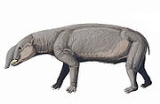
Astrapotheria
Encyclopedia
Astrapotheria is an extinct order of South American hoofed animals. The history of this order is enigmatic, but it may taxonomically belong to Meridiungulata
(along with Notoungulata
, Litopterna
and Pyrotheria
). In turn, Meridungulata is believed to belong to the extant superorder Laurasiatheria
. However, some scientists regard the astrapotheres (and sometimes the Meridiungulata all together) to be members of the clade Atlantogenata
. An example of this order is Astrapotherium magnum
. When alive, Astrapotherium might have resembled a mastodon
, but was only three meters (ten feet) long.
Meridiungulata
Meridiungulata is an extinct clade with the rank of cohort or super-order, containing the South-American ungulates: Pyrotheria , Astrapotheria, Notoungulata and Litopterna...
(along with Notoungulata
Notoungulata
Notoungulata is an extinct order of hoofed, sometimes heavy bodied mammalian ungulates which inhabited South America during the Paleocene to Pleistocene, living from approximately 57 Ma to 11,000 years ago.-Taxonomy:...
, Litopterna
Litopterna
Litopterna is an extinct order of fossil hoofed mammals from the Tertiary period that displays toe reduction. Three-toed, and even a one-toed horselike form developed....
and Pyrotheria
Pyrotheria
Pyrotheria is an order of extinct meridiungulate mammals. These mastodon-like ungulates include the genera Baguatherium, Carolozittelia, Colombitherium, Gryphodon, Propyrotherium, Proticia, and Pyrotherium....
). In turn, Meridungulata is believed to belong to the extant superorder Laurasiatheria
Laurasiatheria
Laurasiatheria is a large group of placental mammals believed to have originated on the northern supercontinent of Laurasia. It includes shrews, hedgehogs, pangolins, bats, whales, most hoofed mammals, and carnivorans, among others....
. However, some scientists regard the astrapotheres (and sometimes the Meridiungulata all together) to be members of the clade Atlantogenata
Atlantogenata
Atlantogenata is a proposed clade of mammals containing the cohorts or super-orders Afrotheria, Xenarthra and Meridiungulata. These groups originated and radiated in the South American and African continents, presumably in the Cretaceous. Together with Boreoeutheria it makes up Eutheria...
. An example of this order is Astrapotherium magnum
Astrapotherium magnum
Astrapotherium magnum is an extinct South American mammal which vaguely resembled a cross between a small elephant, and a very large tapir. It may have fed on marsh plants...
. When alive, Astrapotherium might have resembled a mastodon
Mastodon
Mastodons were large tusked mammal species of the extinct genus Mammut which inhabited Asia, Africa, Europe, North America and Central America from the Oligocene through Pleistocene, 33.9 mya to 11,000 years ago. The American mastodon is the most recent and best known species of the group...
, but was only three meters (ten feet) long.
Classification
- Astrapotheriidae
- ComahuetheriumComahuetheriumComahuetherium is an extinct genus of astrapotherian mammal from the early Miocene . It is a basal astrapotheriid which lived in what is now Patagonia, Argentina...
- XenastrapotheriumXenastrapotheriumXenastrapotherium is an extinct genus of astrapothere, a type of hoofed herbivorous mammal, native to South America, which lived in the mid-Miocene period, during the Laventan stage...
- Synastrapotherium
- Parastrapotherium
- GranastrapotheriumGranastrapotheriumGranastrapotherium is a genus of extinct ungulate mammal described from remains found in rocks of the Honda Group in the desert of Tatacoa in the departments of Huila and Tolima, in Colombia which comprise the fossil site of La Venta, where they surfaced several Miocene vertebrate remains...
- Astrapotherium
- Astrapothericulus
- Astraponotus
- Comahuetherium
- Eoastrapostylopidae
- Eoastrapostylops
- Trigonostylopidae
- TrigonostylopsTrigonostylopsTrigonostylops is an extinct genus of South American ungulate, from the late Paleocene to early Eocene of Argentina.A complete skull of the type species, T. wortmani, has been found, and it has been classified as an astrapothere based on its large lower tusks...
- Albertogaudryia
- Shecenia
- Tetragonostylops
- Trigonostylops

